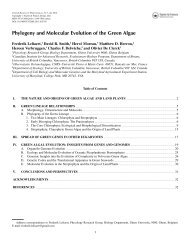The red algal genus Reticulocaulis from the Arabian
The red algal genus Reticulocaulis from the Arabian
The red algal genus Reticulocaulis from the Arabian
You also want an ePaper? Increase the reach of your titles
YUMPU automatically turns print PDFs into web optimized ePapers that Google loves.
50 Phycologia, Vol. 42 (1), 2003<br />
Figs 21–24. <strong>Reticulocaulis</strong> obpyriformis. Habit and vegetative features (SMM 446). ac, axial cell; cfc, cortical filament cell; cpb, carpogonial<br />
branch; pc, periaxial cell. Scale bars 2 cm (Fig. 21); 100 m (Fig. 22); 10 m (Figs 23, 24).<br />
Fig. 21. Holotype (a pressed monoecious specimen).<br />
Fig. 22. Bead-like, inflated axial cells jacketed by derivatives of <strong>the</strong> periaxial cells and by rhizoids that give rise to unbranched secondary<br />
cortical filaments (arrowheads). Primary cortical filaments of obpyriform cells and a carpogonial branch are borne on <strong>the</strong> periaxial cells.<br />
Fig. 23. Direct transformation of a short moniliform branch of a cortical filament into an indeterminate lateral, as indicated by <strong>the</strong> sinusoidal<br />
development of <strong>the</strong> axis behind <strong>the</strong> apical cell (arrow) and <strong>the</strong> alternate production of periaxial cells and cortical filaments.<br />
Fig. 24. Obpyriform and cylindrical cortical cells bearing single or pai<strong>red</strong> moniliform laterals of restricted growth.<br />
ment cell) or a lower cortical filament cell. <strong>The</strong> presence of<br />
two carpogonial branches on a single supporting cell occurs<br />
more frequently than in R. mucosissimus (Fig. 31). <strong>The</strong> hypogynous<br />
cell produces 4–6 branched clusters of densely aggregated<br />
nutritive cells. Cells #3 and #4 generally each bear<br />
two longer branched laterals and 1–3 small nutritive-cell clusters.<br />
<strong>The</strong> carpogonial branch cells proximal to cell #4 bear a<br />
long primary sterile lateral and may ultimately come to bear<br />
an abaxial or adaxial second sterile lateral. As <strong>the</strong> carpogonial<br />
branch matures, sterile laterals become progressively more<br />
branched. Upon fertilization, <strong>the</strong> carpogonial branch cells and<br />
<strong>the</strong> basal cells of <strong>the</strong> sterile laterals inflate, both <strong>the</strong> pit connections<br />
and nuclei of <strong>the</strong>se cells enlarging substantially. <strong>The</strong><br />
gonimoblast initial develops directly <strong>from</strong> <strong>the</strong> fertilized carpogonium.<br />
<strong>The</strong> nutritive cells did not stain because <strong>the</strong>ir contents<br />
were rapidly emptied, and thickened strands between <strong>the</strong><br />
nutritive-cell clusters and <strong>the</strong> hypogynous cell were not seen.<br />
Mature carposporophytes were not observed and hence no<br />
measurements of cystocarpic structures (diameter of cystocarps<br />
and carposporangia) could be made.<br />
Tetrasporophytes are unknown.<br />
DISCUSSION<br />
<strong>The</strong> <strong>Arabian</strong> collections of <strong>Reticulocaulis</strong> extend <strong>the</strong> known<br />
distribution of <strong>the</strong> Naccariaceae <strong>from</strong> <strong>the</strong> Atlantic and <strong>the</strong> Pacific<br />
to <strong>the</strong> north-western Indian Ocean. Both species occur<br />
<strong>the</strong>re in habitats similar to that occupied by R. mucosissimus<br />
in Hawaii, <strong>the</strong> Hawaiian populations forming part of a ‘spring<br />
flora’, which consists mainly of gelatinous species of Acrosymphyton<br />
L.G. Sjöstedt, Dudresnaya, Gibsmithia and<br />
Schmitzia P.C. Silva growing in areas scou<strong>red</strong> by waves 4–10<br />
m in height (I.A. Abbott, personal communication). <strong>The</strong><br />
strong seasonality of members of <strong>the</strong> Naccariaceae has been<br />
documented previously (Dixon & Irvine 1977; Womersley<br />
1996) and we suspect that seasonal growth in <strong>the</strong> nor<strong>the</strong>rn<br />
Indian Ocean may be related to day-length changes and water<br />
temperature. <strong>The</strong> occurrence of R. mucosissimus in Hawaii<br />
and Oman corresponds to previous reports of a biogeographical<br />
affinity of certain <strong>Arabian</strong> Sea biota with distant regions<br />
in <strong>the</strong> Pacific (Coles 1995: Hawaii; Wynne 2000: Japan; Schils<br />
& Coppejans 2002: Australia). <strong>The</strong>se disjunct distributions<br />
can be explained by (1) undersampling of subtidal habitats

















